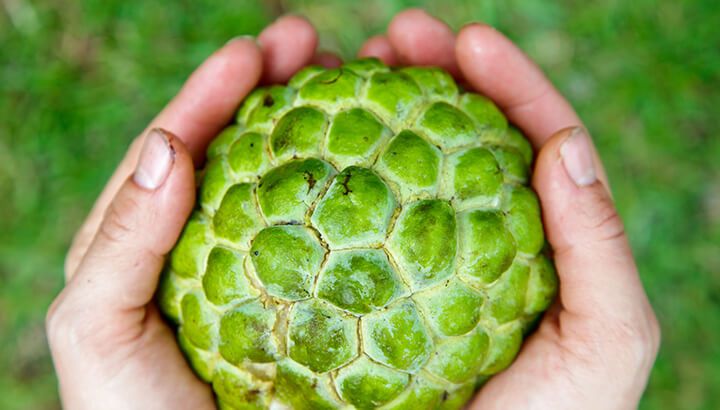Watch out, world. There is a new superfruit in town! Okay, guanabana (Annona muricata), is not exactly new, but it continues to make headlines for its superpowers. Guanabana, also known as soursop, custard apple or Brazilian Paw Paw, comes from the graviola tree that is native to Mexico. It is frequently used in South America for beverages and in candy, and its leaves are made into tea.
What is guanabana?
The guanabana fruit, which is more commonly known to us as soursop, is a prickly fruit with white flesh that is said to have a sweet and sour taste like a combination of strawberries and pineapple with just a hint of sour citrus. The bumpy skin is green and not edible but the white flesh is often used as an ingredient in ice cream, beverages and candy. It is quite nutritious with a variety of B vitamins as well as vitamin C, phosphorus and calcium. Plus, it is high in antioxidants.
In ancient medicine, the fruit, leaves and bark of the tree have been used to cure diseases and disorders like dysentery, diarrhea, worms and even parasites in the digestive system. To this day, in some South American countries, the fruit and leaves are used to treat mucus membranes from the nose, throat and lungs.
Breast cancer treatment
Studies suggest that the antioxidants and phytonutrients of the guanabana fruit fight disease-causing cells, including tumors. In fact, a study conducted in 1997 found that guanabana worked better than chemotherapy in destroying breast cancer cells!
Root canals
During root canals, dentists will usually irrigate the root canal with a chemical solution that is actually found in bleach. However, scientists may have found a better way. A study in the Journal of Contemporary Dental Practice suggests that using guanabana leaves may actually be a much healthier alternative to irrigate the root canal. That’s because guanabana leaves are high in anti-inflammatory and antimicrobial properties. Who knew?
Pancreatic cancer
Pancreatic cancer claims the lives of about 85 percent of patients. It is estimated that at least 44,000 cases are diagnosed each year. Surprisingly, the extract of guanabana has been shown to help reduce rates of pancreatic cancer. A study performed by the University of Nebraska Medical Center found that these cancer cells have a high glucose uptake, but when treated with the guanabana extract their glucose uptake went down, compared to those cells that were left untreated.
Diabetes
Though it has not been studied in humans, laboratory rats saw a 75 percent decrease in blood glucose levels after being treated with extract from guanabana leaves. In combination with a diet low in processed carbohydrates, this could mean that patients with diabetes could see a significant decrease in their blood glucose levels.
Urinary tract infections
Urinary tract or bladder infections are most common in women and can be extremely painful. Usually, doctors prescribe strong antibiotics to treat the infection, but these can come with a host of side effects. The most common alternative treatment is pure cranberry juice or extract, but have you considered guanabana? Some people use this fruit because of its high vitamin C content and the high volume of water it contains. No clinical trials have been performed to support the claim that guanabana is effective, but there is plenty of anecdotal evidence to suggest that it may be able to treat urinary tract infections.
Parasites
Western medicine usually relies on antibiotics to treat parasites, but guanabana has been used in ancient medicines for just this purpose. It is the amino acids, ascorbic acid, thiamin, iron, phosphorus, fiber and riboflavin that are said to inhibit parasites in the body.
Other potential benefits of guanabana
Thanks to the high amount of nutrients in the fruit and leaves, guanabana has been used for medicinal purpose for thousands of years. Vitamin C, for instance, is known to increase endurance and it slows down the aging process. Tryptophan, also naturally-occurring in this fruit, can potentially help with sleep and relaxation. Guanabana is rich in soluble and insoluble fiber which could make it a great relief for constipation. In addition, the extract from the guanabana leaves is frequently used in essential oils and aromatherapy.
How to eat guanabana
If you can find guanabana sold in a store, likely an Asian or Hispanic supermarket, wash the fruit under running water. Sometimes dirt can collect in the bumps, so you may even want to scrub the fruit. It is best to cut the fruit in half and spoon out the flesh, but you can also easily peel the skin and cut the flesh into pieces. Watch out for the seeds; they are not edible and should be spit out like the seeds of a watermelon. Also, do remember that the skin of the fruit is not edible.
Side effects of guanabana
While this superfruit is certainly worth exploring as an addition to a balanced diet, it is advised not to use it in excess. Side effects like diarrhea, excessive sweating and increased body heat have been reported by people who used guanabana in large amounts.
— Susan Patterson

